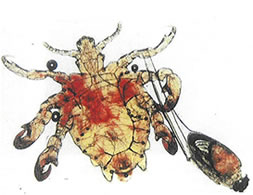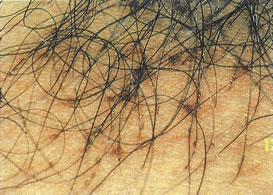Basic Information on Pubic Lice: Identification and Impact
Pubic lice are tiny parasites primarily inhabiting the pubic hair, causing itching and skin irritation. They can also infest other hairy parts of the body, not limited to the genital area.

Identifying Pubic Lice: Main Symptoms and Signs
Typical symptoms of a pubic lice infection include intense itching, redness, and small black dots at the infected site. Prompt medical diagnosis is crucial if these signs are observed.

Itchiness and Discomfort: Early Indicators of Pubic Lice Infection
Common early signs of pubic lice include severe itching caused by the pubic hair and skin redness. These symptoms often worsen at night.
Impact of Pubic Lice on Health
While pubic lice generally cause mild symptoms, chronic itching and scratching can increase the risk of secondary infections.
Skin Issues and the Risk of Secondary Infections
Chronic itching and scratching can make the skin more susceptible to infections, increasing the risk of secondary complications. Proper treatment and care are necessary.
Routes of Infection and Prevention Measures for Pubic Lice
Pubic lice are primarily spread through close physical contact. Indirect transmission through shared clothing or bedding is also possible.
Infection can occur from sources like public bath towels, even in the absence of sexual activity.
Routes of Pubic Lice Infection: Main Causes and Transmission Methods
The most common transmission of pubic lice is through direct skin-to-skin contact, including sexual intercourse. However, they can also be contracted from shared towels or bedding.
Direct Contact: A Common Method of Pubic Lice Spread
Pubic lice easily spread through sexual contact or close skin contact. Therefore, it's crucial to avoid direct skin contact if a pubic lice infection is suspected.
Effective Prevention Methods for Pubic Lice
Preventing pubic lice involves maintaining personal hygiene and avoiding direct contact with infected individuals. Additionally, avoiding shared items and regularly washing bedding and clothing can be effective.
Personal Hygiene and Environmental Management: Preventing Pubic Lice Infection
Preventing pubic lice requires thorough personal hygiene and environmental management. Regular laundering and cleaning can reduce the risk of infection.
Treatment for Pubic Lice: Effective Methods and Considerations
Treatment for pubic lice typically involves the use of medications applied directly to the infected area, effectively eliminating the lice.
Treatment Options for Pubic Lice: Choices and Their Effects
Local application of medicated treatments is used for pubic lice. These treatments effectively eradicate the lice and prevent reinfection.
Topical Agents: Scabimite Shampoo, Scabimite Powder
Medicated Treatment: Removing and Preventing Pubic Lice
Topical medicated treatments, applied directly to the infected areas, effectively remove pubic lice. These include shampoos and creams. Complete hair removal can also be effective.
Considerations During Pubic Lice Treatment
During treatment, it's important to keep the infected area clean and regularly apply the prescribed medication. Avoiding sexual contact and sharing personal items can reduce the risk of reinfection.
Managing the Infection Area and Preventing Recurrence
To prevent the recurrence of pubic lice, managing the infection area and taking preventive measures after treatment are essential. This includes proper use of medication and isolation from the source of infection.
Misconceptions and Facts About Pubic Lice
A common misconception about pubic lice is that poor hygiene is a direct cause, but this is not necessarily true. Anyone can contract pubic lice.
Common Misconceptions and Their Correction
A common misconception about pubic lice is that they are caused by unclean environments or poor hygiene, but this is incorrect. Pubic lice spread through direct contact.
Misunderstandings About Pubic Lice: Fact-Based Understanding
Accurate understanding of pubic lice includes knowing the actual causes of infection and methods of transmission. This is crucial for effective prevention and treatment.
The Relationship Between Pubic Lice and Sexually Transmitted Infections
Although pubic lice are a type of sexually transmitted infection, they can also spread through non-sexual methods. Therefore, prevention and caution are necessary even outside of sexual activities.
Sexually Transmitted Infections and Pubic Lice: Correct Recognition and Precautions
Correct recognition of pubic lice involves understanding their characteristics as sexually transmitted infections and associated risks and prevention methods. This enables effective management of pubic lice.